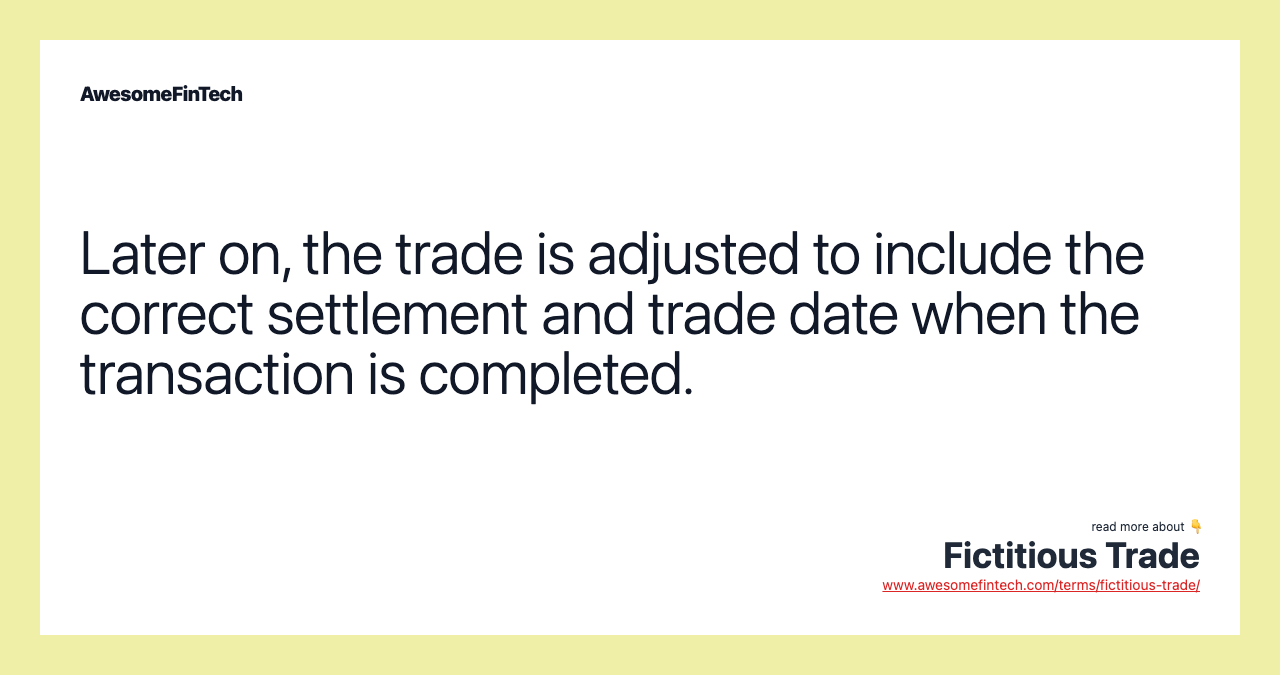Fictitious Trade
A fictitious trade is a trade that is booked with an execution date far in the future and is adjusted to include the correct settlement and trade date when the transaction is completed. A fictitious trade is a trade that is booked with an execution date far in the future and is adjusted to include the correct settlement and trade date when the transaction is completed. The first is a cash transaction with a settlement date (the same as the trade date); the second transaction has the same trade date, but with a settlement date for several weeks later. His underlying positions were disguised by employing late bookings of real trades, booking fictitious trades to internal accounts, and the use of fictitious deferred settlement trades in the British Financial Services Authority (FSA). Later on, the trade is adjusted to include the correct settlement and trade date when the transaction is completed.

What Is a Fictitious Trade?
A fictitious trade is a trade that is booked with an execution date far in the future and is adjusted to include the correct settlement and trade date when the transaction is completed.





How a Fictitious Trade Works
A fictitious trade is used in the processing of a securities transaction as a form of placeholder and is found when open dates or rates are being used.
It also refers to a securities order used to affect the price of a security, but which does not result in shares being competitively bid for and no real change in ownership. Wash sales and matched orders are examples of fictitious trades. A fictitious trade is designed to give the impression that the market is moving in a certain direction, when in fact it is being manipulated by a broker.
Example of a Fictitious Trade
For example, two companies enter into a series of ongoing transactions whose values are based on an interest rate set each week. Because the interest rate can change from week to week, an open execution date is used for the transaction until the interest rate is announced.
Two transactions are recorded. The first is a cash transaction with a settlement date (the same as the trade date); the second transaction has the same trade date, but with a settlement date for several weeks later. Each week, the second transaction is updated to include the correct interest rate and settlement date.
Improper Use of Fictitious Trading
UBS trader Kweku Adoboli was convicted of two counts of fraud in 2012 after his fraudulent trades led to losses of $2.3 billion when he was working in the London office. The losses were incurred primarily on exchange-traded index future positions and were the largest unauthorized trading losses in British history. His underlying positions were disguised by employing late bookings of real trades, booking fictitious trades to internal accounts, and the use of fictitious deferred settlement trades in the British Financial Services Authority (FSA).
The FSA fined UBS AG (UBS) £29.7 million (about $40.9 million), the third-largest fine the regulator had imposed in its history, for systems and controls failings that allowed an employee to cause substantial losses as a result of unauthorized trading.
Related terms:
Admission Board
An admissions board comprises representatives of a particular stock exchange who determine if a company will be allowed to list shares on that exchange. read more
Audit Trail
An audit trail tracks accounting data to its source for verification. Learn how companies use auditing to reconcile accounts and detect fraud. read more
Enron
Enron was a U.S. energy company that perpetrated one of the biggest accounting frauds in history. Read about Enron’s CEO and the company’s demise. read more
Jerome Kerviel
Jerome Kerviel was a trader for Société Générale charged with losing more than $7 billion in company assets through unauthorized trades between 2006 and 2008. read more
Registered Representative (RR)
A registered representative (RR) is a financial professional who works with clients who are trading investments such as stocks and bonds. read more
Wash Trading
Wash trading is the illegal process of buying shares of a company through one broker while selling shares through a different broker. read more